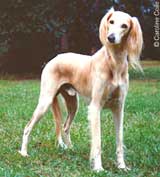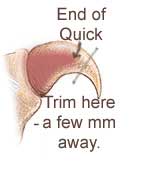
Grooming sessions can become a special bonding time between you and your dog and are also a good opportunity to check on your dog’s health. Look carefully for signs of fleas, ticks, skin irritations, lumps or sore spots. Check your dog’s ears, eyes and teeth regularly and consult your vet about any unusual findings.
Regular grooming program
Longhaired dogs need to be groomed daily, while shorthaired breeds may only need one session per week. Pick a time when your dog is relaxed, such as after walking, and when you have sufficient time. Then grooming will be a pleasurable experience for both of you.
Get your puppy accustomed to grooming early in life. Begin gradually by handling your puppy often, touching its ears and paws gently. Start with short grooming sessions and reward your pup with treats as you do so. He or she will then associate handling and grooming with positive outcomes.
Learn where your dog likes to be combed and brushed – some areas may be more sensitive than others. Find that special spot your dog likes the most and grooming will soon become a special treat for your dog!
Combing
Regular brushing and combing will remove loose or matted hair and helps keep the skin free of diseases and parasites such as fleas. Natural oils will be more evenly distributed to give your dog a nice shiny coat. Comb in the direction of hair growth to remove tangles.
- Fine-toothed combs are used for soft, thin or silky coats, medium-toothed combs are used for normal coats and wide-toothed combs are best for heavy and thick coats
- Flea combs are very fine to remove parasites and flea dirt from the coat and may also be used to comb the hair around the eyes
- Rakes are ideal for removing dead undercoat hair in larger dogs with coarser and thicker coats, like the Golden Retriever or German Shepherd
Brushing
Brush in the direction of hair growth, beginning at the head, and work towards the tail and down the legs. Brushing removes loose hair and daily brushing of longhaired and double-coated dogs removes dead hair from the undercoat to help prevent matting.
- Slicker brushes are ideal for this purpose but are also a good general brush for all breeds if used lightly
- Pin brushes, with rounded tips to prevent damage to the skin, are good for dogs with long, fine hair such as Silky Terriers. They can also be used to fluff the coat by brushing against the direction of hair growth
- Bristle brushes are good for dogs with very long coats, such as the Afghan, and help add shine to the short coat
- Grooming mitts are also good for shorthaired breeds to add polish and shine once the loose hairs are removed.
Clipping your dog’s nails
Keep your dog’s nails regularly trimmed to prevent split and damaged claws. Use nail clippers specially designed for dogs, such as spring-operated guillotine devices or pincher-like nail trimmers for small dogs.
Only clip the tip of each nail, being careful to stop short of the quick where the blood vessels are. Ask your vet to show you the correct technique the first time, especially if your dog has dark nails.
Stopping the bleeding of a trimmed claw can be difficult but they all stop eventually. Try smearing some Vaseline on the claw tip or try applying gentle pressure with a tissue or cotton ball.
Regular exercise on hard ground will help keep the nails trimmed in condition and lengthen the time between trims as the ground acts like an emery board.
Starting young prevents toenail trim terror. Train your puppy to accept claw trims at an early age by allowing it to sniff and explore the trimmer long before the claws are trimmed. For older animals that are terrified or aggressive, your vet’s help is required. Anti-anxiety medication and a program of progressive desensitisation will help change the dog’s association with the nail trimmers to a happier one.
Using food treats, the dog is rewarded if it stays still for a few seconds while its upper leg is scratched with a finger. Once this is achieved, which may take 5 minutes or more, the clippers are introduced, just by touching against the leg for a few seconds while the dog remains still. The dog is rewarded. Gradually the clipper moves down towards the claws, rewarding calm behaviour as you go, then the paw is raised, and then eventually a single claw may be trimmed without a hint of panic.
A process like this is usually effective but it is not quick and the solution can take weeks or months of daily practice. Patience is a virtue!
Cleaning your dog’s ears
Ears can be simply cleaned by using an ear cleaning solution provided by your vet. Ear cleaners remove excess moisture, wax and debris from the outer ear canal. Only use products specifically for dogs and avoid medicated products unless advised by your vet.
Hold up the earflap and dribble a few drops of ear cleaner into the ear canal. Massage gently at the base of the ear (you will hear a squelching sound as you do so) to work in the solution. Stop if this appears to be painful to your pet and consult your vet. Repeat with the other ear.
Use cotton wool to wipe away any excess solution, and to clean out any wax or debris. Use your forefinger and only clean as far as it will naturally reach to avoid hurting the eardrum. Never use cotton buds or poke anything in to the ear as they can damage the sensitive lining of the ear canal or perforate the eardrum.
When checking your dog’s ears, look for any reddening inside the ear, swellings on the ear flap (haematoma)or any discharges and unpleasant odours in the ear. A foul smell may simply indicate your dog’s ears need a good clean or there could be an ear infection or foreign body in the ear.
Any ear problem will cause affected dogs to shake their heads and hang them to the side of the affected ear. Excess shaking and rubbing can lead to aural haematomas. If you suspect your dog has an ear problem seek veterinary help as soon as possible. The eardrum may be damaged so don’t use any ear drops until your vet has looked down the ear with a special instrument (an otoscope).
Eye care
Wipe away any discharge that accumulates at the corner of your dog’s eyes with a damp cotton ball and you can carefully clip any excess long hair around the eyes. Products are available to help reduce discolouration under and around the eyes, especially in white-coated dogs.
If the eyes are weeping excessively you should contact your vet – this could be due to conjunctivitis, a serious ulcer, or abnormalities of the tear duct. If a foreign body such as a grass seed is present your dog may blink excessively and the lids will swell. Symptoms like these or any inflamed eye should be treated as an emergency to avoid serious complications and, at worst, loss of the eye.
Giving your dog a bath
Bathe your dog as necessary with shampoos formulated for dogs only. Frequency depends on the breed of your dog and whether you are using a general shampoo, a medicated shampoo for skin conditions or a flea shampoo or rinse.
A helpful tip is to have everything ready before you start – buckets of lukewarm water or a gentle shower nozzle attached to the tap, non-slip mat if using the bath, shampoo, conditioner or grooming spray, brush or comb, towels, treats and a helper.
Start very slowly, stop and offer your dog treats at each step along the way to keep everyone calm and relaxed. If your dog has a good experience the first time then bathing will be less stressful and more fun in the future for all!
By Provet Resident Vet
Contributors: Dr Julia Adams BVSc
Last updated on 19 August 2019
